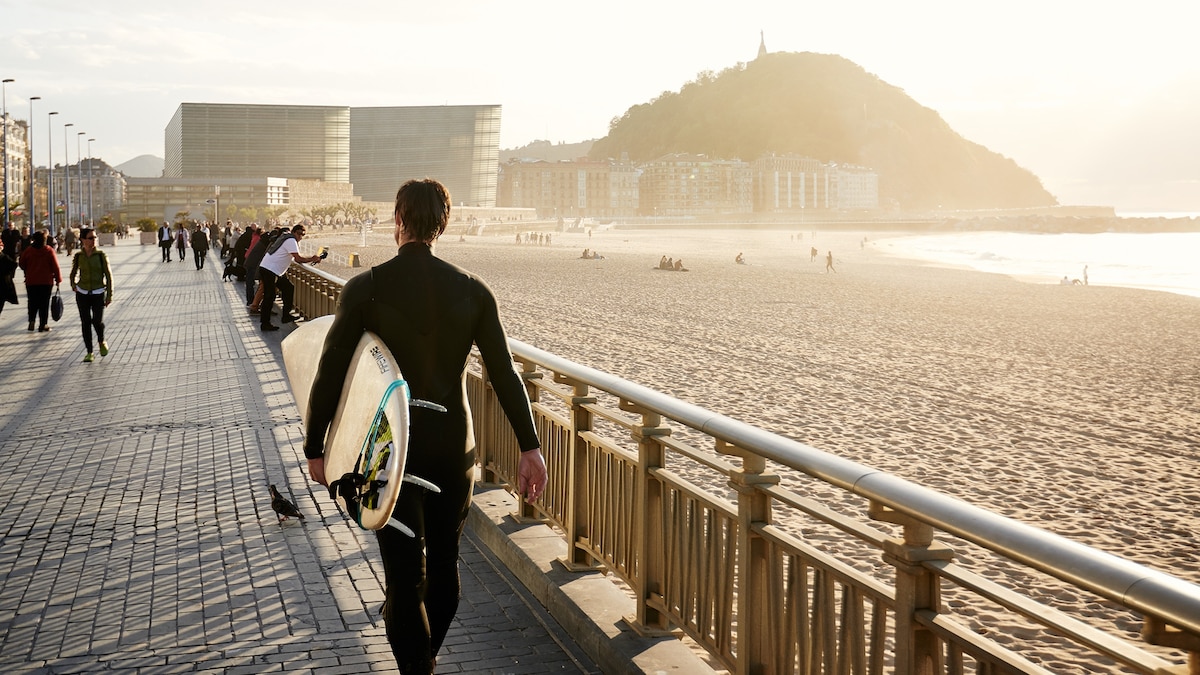Now Reading: 8 of the best beach cities in Spain
-
01
8 of the best beach cities in Spain
8 of the best beach cities in Spain

This article was produced by National Geographic Traveller (UK).
High-spirited northern surf hubs, relaxed Mediterranean-fronting neighbourhoods and glowing sands washed by the thundering Atlantic — mainland Spain’s cities can offer all of this and more. Take your pick of these varied urban beauties, scattered around the country’s 3,000-mile peninsular coast. Beaches in Spain can get packed everywhere during the high season, from July to August, so for the best chance of solitude and space, it’s worth travelling in the quieter shoulder periods.
1. Donostia-San Sebastián
A pair of wide gold beaches, tucked into a crescent-moon bay between forested headlands, sets the scene for one of northern Spain’s most popular coastal escapes. Many San Sebastián strolls begin on the promenade curving past Playa de Ondarreta and Playa de la Concha, both of which are good spots for swimming and paddleboarding, overlooking the Isla de Santa Clara. Just northeast of La Concha, beyond the walkable Parte Vieja and its overflowing pintxo bars, Playa de Zurriola has a more relaxed energy and offers great, beginner-friendly surfing. When you’re done stretching out on the sand or catching Atlantic waves, San Sebastián’s famous gastronomic world awaits.
A special stay: A converted belle époque villa gazing out across La Concha Bay houses the effortlessly cool Nobu Hotel San Sebastián, which has 17 luxurious rooms, a rooftop pool and a signature restaurant. From around €400 (£335), B&B.
2. Valencia
Spain’s third-largest city is home to some of the most enticing and accessible urban beaches in the country, beyond which there are beautifully green parklands, busy fresh-produce markets, a range of top-tier galleries and lively neighbourhoods to discover. East of Valencia’s old centre, the gentle waves of the Mediterranean swoosh onto several miles of soft, honey-coloured sand, officially divided into the Cabanyal, Malvarrosa and Patacona beaches. It’s all bordered by a promenade with palm trees that makes walking, running and cycling here a joy. This is a slice of classic Spanish beach culture — and it’s good fun. Expect a buzzing atmosphere and plenty of straw-topped umbrellas. Indulge in a long lunch of wood-fired paella at somewhere like Casa Carmela opposite Malvarrosa.
A special stay: In Valencia’s historic centre, the five-star Caro Hotel is a stylishly transformed 19th-century mansion near Turia Garden. From €239 (£200).

Backed by low, pastel-walled houses, the mellow-yellow Barceloneta beaches are Barcelona’s most easily accessible patches of sand. For a more local atmosphere, head northeast to the beaches of Bogatell and Mar Bella.
Photograph by Getty Images; Frederic Ferreri

The public terraces at the Centro Botín, a contemporary art gallery on Santander’s promenade, are a great place to take in the ocean view.
Photograph by Getty Images; Ben Roberts
3. Barcelona
Whether you’re going kayaking to catch the view at sunset or joining a volleyball game on the sand, this Catalan city embraces its seafront Mediterranean location no matter the time of year. Backed by low, pastel-walled houses, the mellow-yellow Barceloneta beaches are the city’s most easily accessible patches of sand. For a more local atmosphere, it’s better to head out along the palm-lined seafront promenade to the beaches of Bogatell and Mar Bella, further northeast. Or venture northeast again to the zona de banys (swimming zone) in El Fòrum, where ladders lead straight from a paved bathing area into the turquoise water. There are also plenty of beaches just a short train ride outside the city, such as Castelldefels, with three miles of open, cream-toned sand and a bit of surf, all 25 minutes away from central Barcelona.
A special stay: Glimpse the Marina Port Vell from the pool and rooftop bar at The Serras, an understated five-star hotel with great Catalan food. From €298 (£250).
4. Santander
A 25-minute ferry ride from central Santander’s Los Reginas jetty takes you to Somo Beach, one of northern Spain’s most popular surf hubs. Somo’s pale-gold sands blend into El Puntal, an arrow-shaped beach jutting out into the bay, known locally for its relaxed summer-only restaurants. Santander, capital of the small Cantabria region, has plenty of other enticing beaches thanks to its estuary-side setting on the Bay of Biscay. Among them are El Sardinero, a mile-long sandy sweep; Playa de los Bikinis, named after the swimwear which, some say, was worn here for the first time in Spain; and the undeveloped Costa Quebrada coves north of the city. In the early 20th century, Santander was a favourite coastal escape for Spanish royalty; visit the grand Palacio de la Magdalena on a headland east of the old town.
A special stay: Jardín Secreto, a family-owned boutique bolthole, is a six-room retreat with a sunny back garden in central Santander. From €100 (£84).

In Cádiz, locals enjoy the late spring sunshine at Playa de la Caleta, where there’s a buzz even during the year’s colder months.
Photograph by Getty Images; Ben Roberts
5. Cádiz
Best known for its lively winter carnival, Cádiz sits on a sunny peninsula bathed by the Atlantic, an hour’s drive south of Seville. Local beach culture revolves around several powdery, pale-taupe strands. Arguably the best is Playa de la Victoria, which extends for almost two miles south of the historic centre to meet wilder, dune-backed Playa de la Cortadura. Here, you’ll find people surfing, setting up umbrellas on the broad sands and sipping fino sherry at waterside chiringuitos (beach restaurants). Alternatively, head to Playa de la Caleta on the Old Town’s western edge; even during cooler months, there’s a buzz around sunset. Off the sand, this ancient city founded by the Phoenicians invites exploration with highlights including the Museo de Cádiz and one of Andalucia’s finest flamenco venues, Peña la Perla.
A special stay: The Parador de Cádiz, just north of Playa de la Caleta, offers Atlantic-view rooms, plus a pool that overlooks the water. From €162 (£135), B&B.
6. Tarifa
Catching a pastel-orange sunset over the Strait of Gibraltar from one of Tarifa’s undeveloped beaches shows why this easygoing, surftown at Spain’s southern tip is such a hit. It’s situated on Cádiz’s Costa de la Luz and its main beach is Playa de los Lances, which begins where the Mediterranean meets the Atlantic and stretches across four miles of protected coastline. A 10-minute drive (or a summer shuttle bus) takes you to Punta Paloma Beach, where umbrella pines trickle down to the dunes. Tarifa’s beaches have great swimming, but the Atlantic’s breezes have also created a thriving kitesurfing and windsurfing culture. The small old town dates from the Moorish era and various coastal trails weave out towards viewpoints overlooking neighbouring Morocco.
A special stay: Hotel La Sacristía has peaceful rooms in a creatively restored 17th-century building in Tarifa’s old town, five minutes from the beach. From €110 (£92).
7. A Coruña, Galicia
This dynamic city on Spain’s northwestern Galicia coast benefits from handy train links and its own international airport. A Coruña’s main beach is essentially two sandy, pale-yellow strands in one — Praia de Riazor and Playa del Orzán — curled into a small Atlantic inlet on the northwest side of the centre. It’s at the heart of a lively local surf scene, but the city is also something of an arts hub and has a strong culinary heritage revolving around the fruits of the sea. Picasso lived here as a child in the 1890s and his former family apartment is now the Casa Museo Picasso, while the Museo de Belas Artes da Coruña houses works by Sorolla, Goya, Rubens and others. You can also stroll north to the grand Torre de Hércules lighthouse, of Roman origin, perched on a windswept headland. If you have the time, A Coruña makes an excellent gateway to Galicia’s Rías Altas and Costa da Morte shorelines.
A special stay: Wake to sparkling Atlantic views at Noa Boutique Hotel, which has light-filled rooms surrounded by golden coves and greenery, just 15 minutes’ drive south east of central A Coruña. From €121.50 (£103), B&B.
8. Gijón, Asturias
Gijón fronts the roaring Bay of Biscay on the western coast of green Asturias. Although relatively little-known on the international travel scene, this formerly industrial city of 268,000 people is only a 30-minute drive or a 45-minute bus ride from Asturias Airport. Two swooping sandy beaches await either side of Cimadevilla, Gijón’s charismatic old town, set on an ocean-whipped headland. Framed by a busy promenade, mile-long Playa de San Lorenzo has a well-established surf scene; at its northern end you can peek at the excavated Campo Valdés Roman Baths, dating from the first century BCE. High-energy cider bars fill Cimadevilla’s interlocking streets and squares, serving plates of pungent cheeses from the Picos de Europa mountains. Just east, Playa de Poniente is another enticing half-moon to relax on, while the surrounding coastline is dotted with wild beaches, including Playa de Rodiles, set within a eucalyptus-shaded nature reserve.
A special stay: Just steps from Playa de Poniente, El Môderne is a distinctive art deco building restored as a moodily styled boutique hotel. ‘Loft’ rooms have private terraces. From €116 (£98).
Published in the June 2025 issue of National Geographic Traveller (UK).
To subscribe to National Geographic Traveller (UK) magazine click here. (Available in select countries only).























